Although the first project on a major river, eco-compensation has been practiced in China for years.
It is easier to establish an ecological compensation mechanism within a province. At present, 11 provinces, including Shandong and Henan, have established provincial compensation mechanisms for ecological protection in river basins within their borders. Shandong took the lead in rolling out eco-compensation in all 133 counties within river basins. Progress on inter-provincial eco-compensation, however, is comparatively slow.
At the end of 2010, government agencies gave 50 million yuan (US$7.4m) to Anhui Province to launch the first inter-provincial horizontal eco-compensation program along the Xin’an River, which flows from Anhui to Zhejiang Province, an early example of the scheme. In 2011, Anhui and Zhejiang started the “Xin’an River model” composed of central financial compensation plus local compensation. It was the first inter-provincial river basin eco-compensation mechanism in China. Since 2012, central government funding provided incentive to Anhui to improve the river’s water quality. If it met the agreed standard, Zhejiang would pay Anhui about 100 million yuan (US$14.8m) that year. According to the Anhui-based Huangshan Daily on July 19, water quality in the river had matched the metrics set in the agreement for 11 years in a row and reached Class II to III in different parts.
In 2011, the governments of four cities in Shaanxi Province including capital Xi’an, as well as a national agri-tech park, and two cities in neighboring Gansu Province signed the Framework Agreement on the Wei River Basin Environmental Protection Cities Alliance, later issuing a series of river basin protection regulations.
In 2016, the Ministry of Finance and other central government departments issued “Guiding Suggestions for Speeding up of Establishment of River Basin Upstream and Downstream Horizontal Ecological Protection Compensation Mechanism,” requiring all provinces and regions to set up horizontal ecological protection compensation mechanisms by 2020, and explore pilot programs for ecological compensation along cross-provincial rivers. By 2025, the schemes are expected to expand.
So far, according to the Ministry of Ecology and Environment (MEE), it has coordinated with 18 provinces and signed 13 inter-provincial watershed horizontal eco-compensation agreements, half of which have fulfilled at least one round of compensation agreements.
Addressing the significance of the eco-compensation between Shandong and Henan, Jin Leshan, director of the China Ecological Compensation Policy Research Center, told the Beijing News in early July that most ecological compensation practices for river basins centered on southern China, especially the Yangtze River basin. The Shandong-Henan scheme shifts the focus north and to the main stream of the Yellow River rather than tributaries.
However, there are still many challenges to these schemes. According to Yu Wenxuan, China has not yet formulated a specific law, with legal provisions scattered in the Law of Environmental Protection, the Yangtze River Protection Law, and the Forest Law of China.
These laws advocate for and encourage regulation, but they lack provisions on the scope, object, subject demarcation, funding source, compensation standard and fund management. Some government departments suggested plans. However, environmental experts said these documents are mostly advisory and carry little legal weight.
Yu said the most common way the scheme works is through direct cash payments. However, this method does not ensure the long-term effectiveness and stability of the ecological compensation. The timely placement of compensation funds also directly affects implementation. Also, some ecological interests are difficult to quantify through money, which makes determining compensation standards more difficult. “There are also no clear norms on the ways and procedures of eco-compensation,” Yu added.

 Old Version
Old Version


